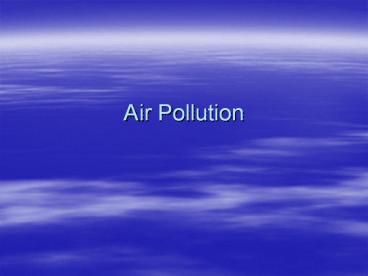Air Pollution - PowerPoint PPT Presentation
1 / 17
Title:
Air Pollution
Description:
Air Pollution Questions for Today What are the basics we need to understand about the atmosphere? What are the two types of pollutants in our Air? – PowerPoint PPT presentation
Number of Views:352
Avg rating:3.0/5.0
Title: Air Pollution
1
Air Pollution
2
Questions for Today
- What are the basics we need to understand about
the atmosphere? - What are the two types of pollutants in our Air?
- What are the major Primary Pollutants in our Air?
3
STRUCTURE AND SCIENCE OF THE ATMOSPHERE
- The atmosphere consists of several layers with
different temperatures, pressures, and
compositions.
Figure 19-2
4
Composition of the Atmosphere
- Components Oxygen 21, Nitrogen 78
- Layers troposphere, stratosphere, mesosphere,
thermosphere, exosphere (extends from 310 miles
to interplanetary space)
5
STRUCTURE AND SCIENCE OF THE ATMOSPHERE
- The atmospheres innermost layer (troposphere) is
made up mostly of nitrogen and oxygen, with
smaller amounts of water vapor and CO2. - Ozone in the atmospheres second layer
(stratosphere) filters out most of the suns UV
radiation that is harmful to us and most other
species.
6
Atmospheric pressure (millibars)
Temperature
Pressure
Thermosphere
Mesopause
Heating via ozone
Mesosphere
Altitude (kilometers)
Altitude (miles)
Stratopause
Stratosphere
Tropopause
Ozone layer
Heating from the earth
Troposphere
Pressure 1,000 millibars at ground level
(Sea level)
Temperature (C)
Fig. 19-2, p. 440
7
Composition of the Atmosphere (cont.)
- Primary Pollutants methane, ozone, dust
particles, microorganisms, and chlorofluorocarbons
(CFCs) - Causes of Primary Pollutants factories, cars,
wind and soil, volcanoes, forest fires, pollen,
decaying plants, salt particles from the sea, and
refrigerants.
8
AIR POLLUTION
- Some primary air pollutants may react with one
another or with other chemicals in the air to
form secondary air pollutants.
Figure 19-3
9
Primary Pollutants
Secondary Pollutants
CO
CO2
SO2
NO
NO2
SO3
Most hydrocarbons
HNO3
H3SO4
Most suspended particles
H2O2
O3
PANs
Most NO3 and SO42 salts
Natural
Stationary
Sources
Mobile
Fig. 19-3, p. 442
10
Major Air Pollutants
- Carbon oxides
- Carbon monoxide (CO) is a highly toxic gas that
forms during the incomplete combustion of
carbon-containing materials. - 93 of carbon dioxide (CO2) in the troposphere
occurs as a result of the carbon cycle. - 7 of CO2 in the troposphere occurs as a result
of human activities (mostly burning fossil
fuels). - It is not regulated as a pollutant under the U.S.
Clean Air Act.
11
Major Air Pollutants
- Nitrogen oxides and nitric acid
- Nitrogen oxide (NO) forms when nitrogen and
oxygen gas in air react at the high-combustion
temperatures in automobile engines and
coal-burning plants. NO can also form from
lightening and certain soil bacteria. - NO reacts with air to form NO2.
- NO2 reacts with water vapor in the air to form
nitric acid (HNO3) and nitrate salts (NO3-) which
are components of acid deposition.
12
Major Air Pollutants
- Sulfur dioxide (SO2) and sulfuric acid
- About one-third of SO2 in the troposphere occurs
naturally through the sulfur cycle. - Two-thirds come from human sources, mostly
combustion (S O2 ? SO2) of sulfur-containing
coal and from oil refining and smelting of
sulfide ores. - SO2 in the atmosphere can be converted to
sulfuric acid (H2SO4) and sulfate salts (SO42-)
that return to earth as a component of acid
deposition.
13
Major Air Pollutants
- Suspended particulate matter (SPM)
- Consists of a variety of solid particles and
liquid droplets small and light enough to remain
suspended in the air. - The most harmful forms of SPM are fine particles
(PM-10, with an average diameter lt 10
micrometers) and ultrafine particles (PM-2.5). - According to the EPA, SPM is responsible for
about 60,000 premature deaths a year in the U.S.
14
Major Air Pollutants
- Ozone (O3)
- Is a highly reactive gas that is a major
component of photochemical smog. - It can
- Cause and aggravate respiratory illness.
- Can aggravate heart disease.
- Damage plants, rubber in tires, fabrics, and
paints.
15
Major Air Pollutants
- Volatile organic compounds (VOCs)
- Most are hydorcarbons emitted by the leaves of
many plants and methane. - About two thirds of global methane emissions
comes from human sources. - Other VOCs include industrial solvents such as
trichlorethylene (TCE), benzene, and vinyl
chloride. - Long-term exposure to benzene can cause cancer,
blood disorders, and immune system damage.
16
Major Air Pollutants
- Radon (Rn)
- Is a naturally occurring radioactive gas found in
some types of soil and rock. - It can seep into homes and buildings sitting
above such deposits.
17
Case Study Radioactive Radon
- Radon-222, a radioactive gas found in some soils
and rocks, can seep into some houses and increase
the risk of lung cancer.
Sources and paths of entry for indoor radon-222
gas.
Figure 19-13

